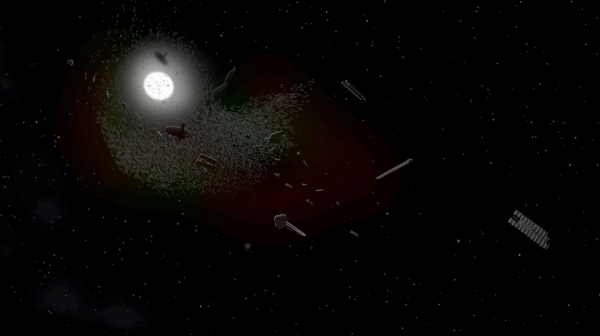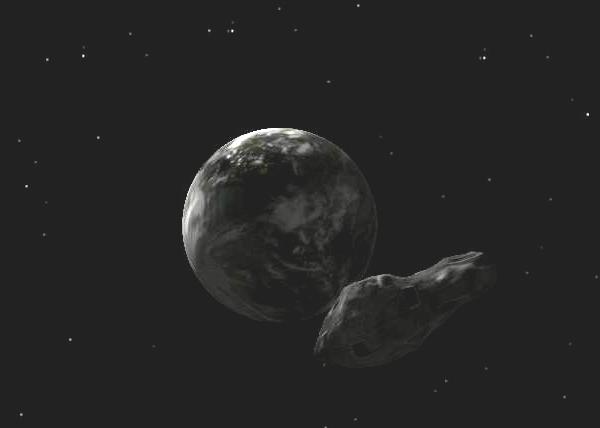BY LETTER
Caph (Beta Cassiopeiae)
Galactography > Regions of Space > Inner Sphere
Galactography > Systems and Worlds > Systems & Worlds C - D
Galactography > Systems and Worlds > Systems & Worlds C - D
Beta Cassiopeiae, a Cinder System | |
 Image from Steve Bowers | |
| A general view of the debris in this system shortly after the collapse. Scrap dealers, archaeologists and tech salvage experts competed against each other to rescue as much of value as possible before collisions caused too much damage. | |
Caph - Data Panel | |
| System | Location: - Distance from Sol: 54.74 ly (J2000) - Constellation: Cassiopeia |
|---|---|
| Star | Names: Caph, Beta Cassiopeiae, 11 Cassiopeiae, Gliese 8 (GJ 8), HD 432, HIP 746 Physical characteristics: - Mass: 1.77 x Sol - Radius: 3.79 x Sol (equator), 3.06 x Sol (pole) - Oblateness: 0.193 - Temperature: 6,167 Kelvin (average). 7,208 Kelvin (pole) - Luminosity: 21.3 x Sol (bolometric) - Spectral type: F2 III - Rotation period: 21.4 hr - Age: 1.18 billion years System: While the star's name likely originated from ancient Arabia, the planets' names were assigned during the First Federation era. It is believed that these names were the names of the key researchers whose works were integral to the Caph colonization project. 1. Johnson - 0.168 AU Vesperian Hephaestian IgneoGaian 2. Kusuma - 0.257 AU Vesperian EnstatianNeptunian. 3. Shenach - 0.437 AU PyroAzurianNeptunian. 4. Lellouche - 0.680 AU ChloridianJovian. 5. Oghensen - 0.948 AU SulfolianNeptunian. 6. Noorani - 1.691 AU SulfolianNeptunian. 7. Ansari - 3.811 AU AcidianJovian. 8. Guanting - 6.489 AU HydroJovian. 9. Sovandary - 11.042 AU HydroJovian. 10. Jawara - 19.456 AU AmmoJovian. 11. Ramirez - 30.542 AU AmmoNeptunian. 12. Khondakar - 56.730 AU TholianNeptunian. Although nearly all satellites in the Caph system were completely disassembled, the conflict disrupted the planetary deconstruction projects. As a result, all major planets survived, although many were heavily altered and became moonless. The system was subsequently infested by rogue autowars, which continue to pose a hazard (despite various mitigation strategies). |
| Governance and Administration | System polity: none centralized Allegiance: Mostly either independent or Solarist. Overseer: none |
| Population | 1.7 billion permanent, virtually all in the outer system. |
| Travel | Wormhole: When All Falls... (1,700 m) to Relay 2 A few Lightway and beamrider stations in the outer system, reestablished after the collapse of the Children of the Caph civilization. |
The Children of Caph
One of the methods used by the Federation of Sophonts to allow colonization of distant systems was the seed ship, one variant of which included human zygotes, embryos or gametes, and a combination of artificial wombs and robotic parents (known as parental vecs) which could be used to raise children in the new system. Several systems in the Cassiopeia direction, such as Achird, were colonized in this fashion.Beta Cassiopeiae, known as Caph, 54.7 light-years from Sol, was colonized in 1532 AT using seed ships and parental vecs, and a successful vec-biont hybrid civilization developed there, nominally aligned with the Solar Dominion. However, the system became cut off during the Version War, suspected by both the Dominion and by Metasoft of treachery; the civilization did not re-establish contact with the Sephirotic civilization after the War. During this period, it developed in a new and somewhat disturbing direction. The parental vecs adapted themselves for large scale child-rearing and constructed vast incubation factories turning out millions of sophonts per day. At the same time, many of the objects in the system were either disassembled or converted into ecumenopolis worlds, and billions of rotating space habitats (large and small) sprung up throughout the system.
At the start of the 55th century, the Caph system held a population of 50 trillion sophonts, verging on disturbingly large by the standards of the day. More problematic for many observers in nearby systems was the rise of expansionist movements and meme sets as well as multiple rumors that various factions in the system were preparing to launch vast numbers of colonization starships - both short-range and long-range - in several directions. These concerns were exacerbated by Caph's own 'official' announcements and reports of discoveries of thousands of objects in the system that could be interpreted as either colony ships or habitats. However, none of the colonization ultimately succeeded. In 5409, the star flared catastrophically. Caph was well-known as a variable Delta Scuti-type star prone to outburst, but a system of magnetic management systems had been in place for several thousand years without incident. The failure of these systems may have been a deliberate act of sabotage - but the responsible party or faction is not known for certain.
Regardless, this event, which affected hundreds of millions of habitats, served to cause several ongoing regional conflicts to expand into total warfare between most factions within the system. Strife within the political economy had led to a build-up of social tension over unequal resource distribution, culminating in a single devastating system-wide war. The collapse of the Caph civilization followed, and fierce subsequent wars and rogue autowars quickly decimated the remaining population. Several starships were indeed observed attempting to escape the system, but most failed, and people aboard the few that successfully escaped were intercepted and reprogrammed to prevent further population explosions. In the aftermath, Caph became a cinder system, massively depopulated and ravaged by feral combat swarms for many centuries afterwards.
The debris swarm left behind after the collapse of this culture has been explored and exploited by several waves of incomers; sometimes a habitat or spacecraft can be repaired and utilised, or disassembled for component parts. Historians and archaeologists are still trying to piece together the chaotic events that occurred in the last years of the Caph civilisation. In the Current Era most who visit this system are thrillseekers looking for a new adventure in a mass graveyard haunted by archaic autowars.
This system is often quoted as a warning against over-rapid, exponentiating population growth; if the rapidly reproducing Children of Caph had in fact started to colonize the nearby systems, they would soon have exhausted those systems too, leaving an expanding shell of depleted systems behind them in a process sometimes known as 'burning the cosmic commons'. Whenever such a rapidly reproducing, exponentiating swarm of colonizers has emerged in the Terragen sphere, it has been suppressed or has failed in one way or another. Many commentators believe that this is a deliberate strategy by the Sephirotic Gods and other metaempires, anxious to avoid the destruction of the resources of the Galaxy.
 Image from Steve Bowers | |
| The world formerly known as Guanting is now a cinderworld, extensively altered by mining and warfare. The Children of Caph were expanding rapidly and were preparing to expand into the neighbouring systems, but instead suffered a rapid and catastrophic collapse. | |
Related Articles
Appears in Topics
Development Notes
Text by The Astronomer, Todd Drashner, Dangerous Safety (2020)
From an original article by Steve Bowers and John B
Initially published on 31 December 2007.
Updated and cleaned up the data panel (2022-02-12, by The Astronomer)
From an original article by Steve Bowers and John B
Initially published on 31 December 2007.
Updated and cleaned up the data panel (2022-02-12, by The Astronomer)






